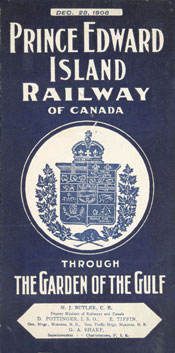Prince Edward Island Railway Reporting mark: PEIR
It was 1871 and railway fever was in the air. At the time PEI was still a British colony and long resistant to the ways of the mainland. However once it caught railway fever, there was no looking back. Construction began in October 1871 with Schreiber and Burpee (Collingwood Schreiber and Isaac Burpee) acting as contractors.

National Archives
The project was poorly planned from the outset. The government neglected to stipulate both the length and route of the railway. As a result, influence peddling ran rampant with lobbyists stuffing money into politicians' pockets in an attempt to buy a station for their community. In addition to the bribes, the government had agreed to pay a fixed cost per mile, but had failed to put a limit on the number of miles to be built. As the result the contractors - not the government - had full control over the construction.
Although it has been speculated that the contractors had a financial incentive to overbuild, there's nothing in Schreiber's early or later careers to back that up. Schreiber was an engineer who began working with Sandford Fleming in 1856. He served as an engineer for the Intercolonial Railway (IRC) during the 1860s and in 1873 joined the civil service to become chief engineer for all the government-owned railways. Throughout his entire career, he was highly regarded for efficiency and cost-effectiveness. Regardless, the narrow-gauge PEIR ended up with some of the curviest roads in the world and stations roughly every two and a half miles (4 km) apart.
By the end of 1872, it was obvious the government had blundered badly. Even after the government was kicked out of office, there was no way out. The staggering debt-load, coupled with the obligation to complete the railway contract, cost the small island colony its independence. On July 1, 1873, Prince Edward Island joined up with Canada to become a separate province. The deal included an agreement for the federal government to take over the railway, which then became the property of Canada and in turn relieved the islanders from the massive debt.
Strategically the PEIR fitted in well with the government's plans for railway expansion. The government at that point was in the midst of building the IRC to connect the mainland ports with central Canada. Several new lines and branches were added to the PEIR. These included a connection to the Northumberland Strait at Cape Traverse, where iceboats operated during the winter months. A new line was built from Charlottetown to Murray Harbour and branches were added to Vernon Bridge, Montague and Elmira.
In 1915 the PEIR became part of Canadian Government Railways (CGR). During that period in 1917, a railcar ferry, equipped to handle 12 rail cars, went into service. The facilities at Port Borden were upgraded and expanded to eventually supplant the facilities at Cape Traverse. As well, the tracks were upgraded to dual-gauge in order to handle cars from the mainland that ran on standard gauge.
The CGR only lasted a brief three years. In 1918, following the bankruptcy and nationalization of the Canadian Northern Railway, all government-owned railways were rolled into the newly formed Canadian National Railways (CN). By 1923, the PEIR officially became known as CN. Shortly after that CN began switching the railway to standard gauge, which was fully completed by 1930.
During the 30s and 40s, CN continued to make modest expansions. A small short line was built from Maple Hill Junction to connect with the Murray Harbour track, in order to bypass the Hillsborough River Bridge which was no longer stable enough to carry standard gauge cars. During World War II, a small spur line was added to connect with CFB Summerside. Connections were also added to a radar base in Tignish and a flight training school in Mount Pleasant. The PEI operations were fully dieselized by the late 1940s, in order to cut the cost of hauling coal over to the island.
Railway traffic dropped swiftly during the 1950s. Improved roads and the popularity of the automobile led to a sharp decline in passenger travel. Passenger service was replaced by buses in 1968. Freight, primarily agricultural produce, gradually began to shift over to trucks. The decline was accelerated by the degraded track and infrastructure, which CN saw no reason to improve.
By the early 1980s, all freight traffic in Atlantic Canada was in a tailspin. CN made it clear that they wanted out. Deregulation of the rail industry in 1987 was the final straw. CN finally abandoned all its rail service on Prince Edward Island in December 1989.
As part of its agreement to provide steamship service to the mainland CN, and later CN Marine, provided regular ferry service across the Northumberland Strait from 1918-86. That was replaced by Marine Atlantic until 1997 when the Confederation Bridge opened.
With the departure of CN from the island, the provincial government was given a one-time subsidy of $200 million to improve its road system. The former CN right-of-way, now owned by the province, has now been converted to a recreational trail. Many of the original stations still exist and remain in use for various purposes.
